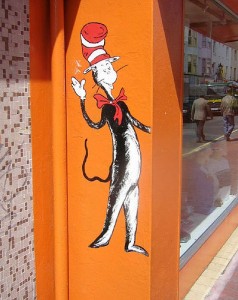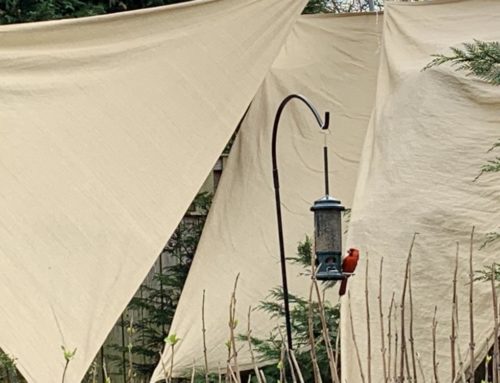March second! March second!
March Second! March Deuce!
I say it to celebrate good Dr. Seuss!
Today was his birthday
He’d be one-oh-eight!
Hooray to the man!
Though he’s late, he was great!
To think Seuss does not seem
To remind of Bernays
Nonetheless, our good rhyme king
Does have his place
In teaching us that in our own operations
We must always dream big about public relations.
So gather ”˜round, comm-heads
Come one and come all!
I call you to WUL,
You I do call
To see what we can learn
From words written in ink
From the man who said
Think of the Thinks you can Think!
_____
And that’s about all the rhyming I’ll do. I’m a Mr. Cohen, not a Dr. Seuss.
Seuss’s way of seeing the world was so cleverly creative that kids couldn’t help but want to read, something that no other author before him could persuade them to do.
More importantly, Seuss’s books always came with some kind of lesson or understanding of the world. These lessons aren’t lost on me. In fact, most of them are still applicable to the world as we see it.
Seuss had an unusual way of communicating, no doubt, but he also seemed to talk about how we should communicate and live as we communicate.
Allow me to demonstrate with five Dr. Seuss books imparting upon us important, fundamental lessons of PR.
#1: One Fish Two Fish Red Fish Blue Fish, 1960
Summary: Seuss teaches kids to count and understand colors with his array of interesting creatures grouped in different sized groups, with differing shades.
How this helps a tiny, growing, future PR pro: Understanding numbers and segmentation is a key to any job.
Particularly, public relations and baseball have benefitted from advanced statistics over the last 10 years. As communication has moved to the Net, we have come to measure more and more of what we see and see it show up in results.
Only by knowing the difference between whether there is one fish or if there are two, and whether they are red or blue can we ever tell which bait reels in the most fish in the first place, ya dig?
#2: Oh, the Thinks You Can Think!, 1975
Summary: The magical world envisioned by the author is brought to life with a series of purely imagined creatures and places.
How this helps a tiny, growing, future PR pro: PR is a creative job. While there is some structure to what we do, imagination is still the king of communication. Coming up with new ways to convey ideas is our duty and responsibility.
Exercise your imagination by thinking of unusual thinks.
#3: Because a Little Bug Went Ka-Choo!!, 1975
Summary: A tiny bug sneezes, creating a butterfly effect that ripples through a town and leads to uncertain outcomes.
How this helps a tiny, growing, future PR pro: There is first the uncertain, immeasurable outcome that is to occasionally occur with our actions, some of which are intentional and some of which are accidental.
We must also always consider our actions in a broader context. Even if we are a little bug, a whole town (or blogosphere, or organization) may be at stake.
#4: The Butter Battle Book, 1984
Summary: The Zooks and the Yooks get into a cold war over how to butter toast, leading them to an indefinite brink of mutually assured destruction.
How this helps a tiny, growing, future PR pro: The Butter Battle Book is a great way to introduce the stupidity of cold war threats to a young person, but it also teaches us never to get into a scenario of heightened tension and mutually assured damage. There is too much at stake and too much energy spent on meeting our doom to ever force people to hold such a consequence against one another.
The Cold War of PR professionals? Nuclear ad campaigns. Stay away from them. Just ask AT&T.
#5: Yertle the Turtle and Other Stories, 1958
Summary: Yertle is the lowliest turtle in all the land. The King decides to stack his subjects (the other turtles) on top of one another until he is the highest thing in the whole universe, suggesting that this will expand his territory. All is well for the king (not so well for the turtles) until Yertle, the bottom turtle, sneezes, crumbling the tower made from his fellow countrymen and leaving the king in a pile of muck.
How this helps a tiny, growing, future PR pro: A couple of points to take from this. We could take the approach that you are only as strong as your weakest link and should keep only top notch professionals beneath you in your organizational structure.
We could also view the moral as a sort of “shrug shrug, things happen” tale. But really, Yertle the turtle is about not getting greedy and treating your fellow turtles with respect.
Rigid, top-down organizations tend to end up with the king in the muck.
Image: What What via Flickr, CC 2.0
![[EVENT]: PR Hacks for Small Biz (online)](https://shonaliburke.com/wp-content/uploads/2021/06/FB-Ad-1200x800-01-01-01-Copy-500x383.jpeg)








@GregChase @jbecher Thanks for the RT! Proud to be part of your feeds.
Thanks so much Shonali Burke! Feels good to make people smile!
When I first read Daniel Cohen’s draft, it put such a smile on my face. Reading the post again today made me smile even more.
OK Finally here to comment. You forgot that Dr Seuss is a left wing corrupter of children turning them into tree loving, anti-prosperity, liberals. Or so the Right Wing in the US has been saying lately since the Lorax was made.
HOW CAN ANYONE NOT LOVE DR SEUSS? Somehow I think too many kids are beaten with a stick growing up by their folks, they then beat their kids and so on. Very sad.
Love your list Mr Dan!
@HowieSPM You’re making me feel deprived because I didn’t grow up with Dr. Seuss… not like American children did, anyway.
@jgarant And @mrdancohen is going to get a lot of people rhyming, I suspect…
@mrdancohen such a wordsmith Sir- congrats on the great post! Brilliant observations for PR pros drawn from the incomparable mind and works of Dr. Seuss. As a matter of fact, even as I sit here looking at my bookshelf, I’m flicking through some of my favourite works and thinking how their stories and lessons apply to us communication professionals. @shonali …perhaps all of us here at WUL need to put up a post about our favourite author and comms lessons? Thanks again Daniel, really gave me a lot to think about with this post.
@JGarant Thanks! Knowledge is power, right? Our profession is a great mixture of academic and artistic when we practice up to our maximum capacity. If you message for a living, it would only make sense that some of the world’s greatest messengers would influence you in a positive way.
I dig the post idea about favorite authors. There’s more than just “a little something” there. I’d love to see who everyone reads. @shonali , I feel like Howie’s would be awesome.
@JGarant Go for it! @mrdancohen
@chillygal @shonali Thanks for the RT!
@chillygal Thanks for sharing @mrdancohen post!
@ErinMFeldman @shonali Thanks for RT Erin!
@mrdancohen Of course! Are you a Shel Silverstein fan as well?
@ErinMFeldman BIG TIME Shel fan. Grew up with him. Have an illustrator friend who reminds me a little of Shel, @rosenbaumdraws
@mrdancohen Very cool! I recently picked up a copy of Runny Babbit, but The Giving Tree was the popular one at my house when I was a kid.
I’m a Dr. Seuss lover too! Great post and tribute too Dr. Seuss, and I love how you made it relevant to PR pros. His books have great lessons and taught me a lot growing up. Like you said his style was irreplaceable.
Thanks Yvette! I would really love to start writing press releases Seuss style.
Thanks Kaarina! “Oh the Places You’ll Go” is in my headboard book space at home. I believe I did actually get it upon graduation from high school. His style was irreplaceable (certainly better than Dick and Jane, right?). Thanks again for reading, from one Seuss lover to another.
I.love.Dr.Seuss. And I especially love “Oh the Places You’ll Go”. I give it as graduation gifts, and on the birth of a baby.I’m not a PR professional, but ” I dig”: the lessons in Dr. Seuss are applicable to so many things in life. Great post, great tribute to Seuss, great lessons. Cheers! Kaarina